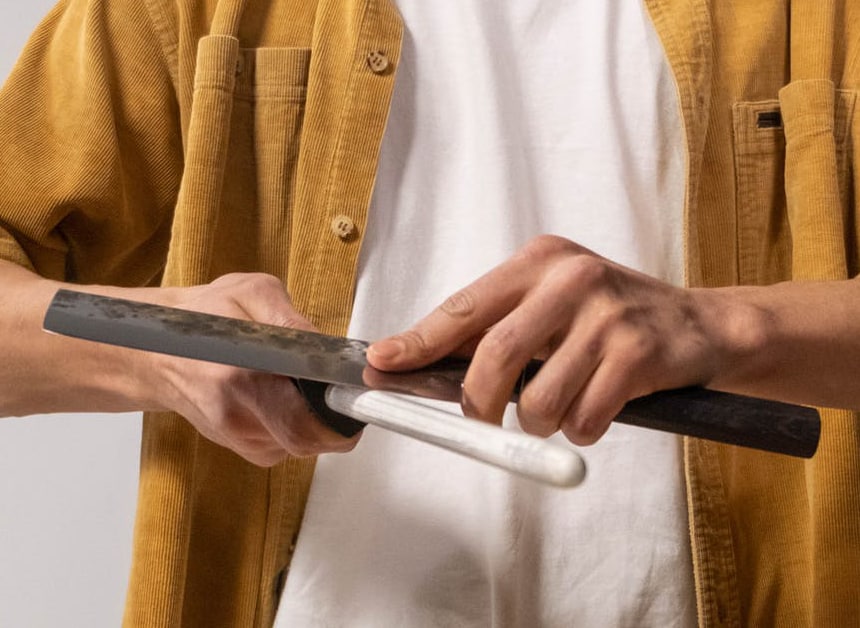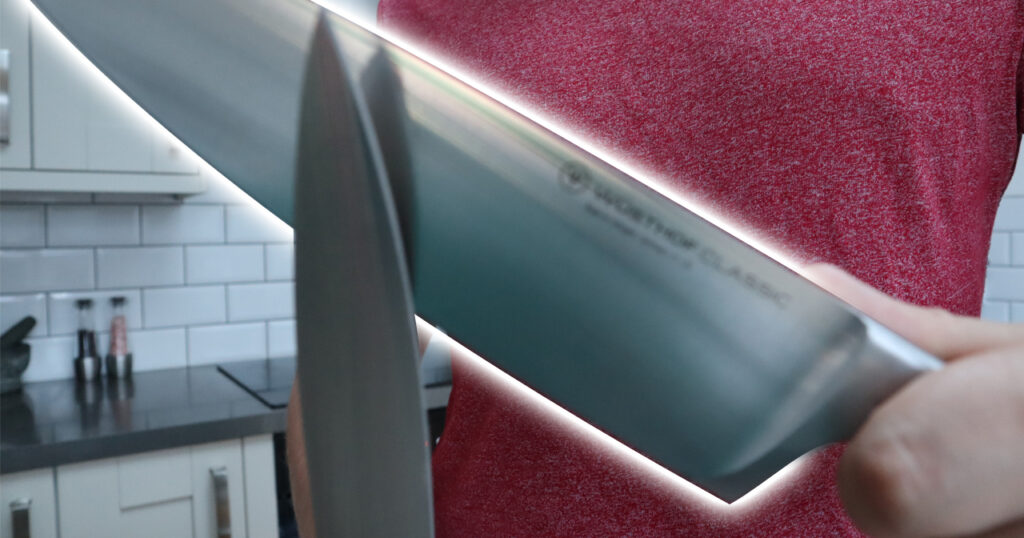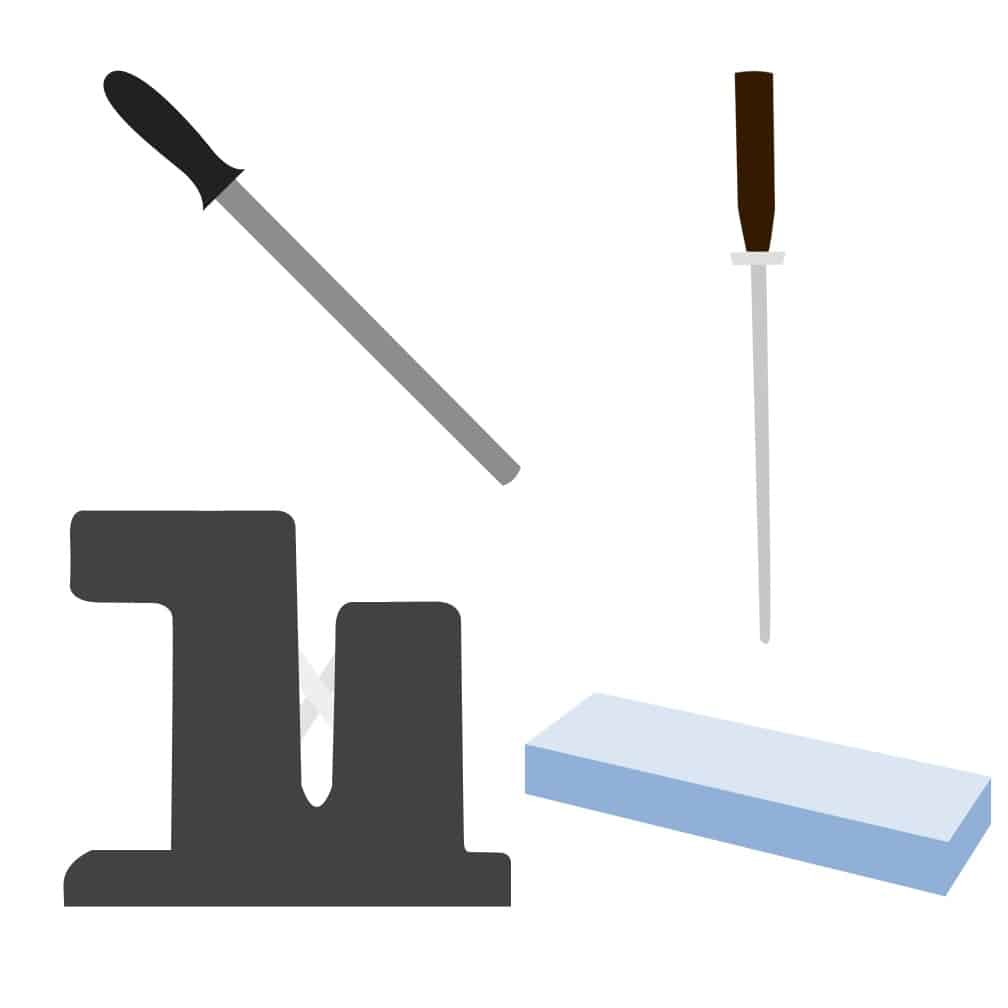
There is a lot of confusion surrounding honing steels and sharpeners and exactly what the difference is. I often see honing steels mistakenly labeled as sharpening rods even when they are being sold, especially online.
The truth is that honing steels and sharpeners are different tools for very different jobs.
If you’re not sure what the difference between honing steels and sharpeners is then read on.
I’ll go into detail about the difference, why it matters, how often you need to hone and sharpen and how you can easily find the correct tools to do the job without getting misled by inaccurate marketing.
Honing steels realigning a blade when the edge has been folded over. Knife sharpeners remove a layer of the blade to reveal a new sharp blade edge. Honing steels are made from material similar in strength to steel blades. Sharpeners must be made from a harder material, such as diamond, ceramic or an abrasive material such as stone, so they can remove steel from the blade.
Looking for a new honing steel?
I recommend the Wüsthof 10 Inch. You can view it on Amazon here (opens new tab).
Looking for a new sharpening rod?
I recommend this Messermeister ceramic rod. You can view it one Amazon here (opens new tab).
Honing steel vs sharpening steel
Firstly, there isn’t really such a thing as a sharpening ‘steel’. Sharpening devices need to be made from a harder material than the knife, so they are usually ceramic or diamond-encrusted.
Sharpening ‘steels’ should really be called sharpening ‘rods’. Anything that is made from steel is likely to be a honing device.
There is a large difference between a honing steel and sharpening rod.
I’ll go into lots of detail below about each one, but in summary:
- Honing steels realign a blade to make a straighter edge
- Sharpening rods remove a thin layer of the blade, to reveal a fresh sharp edge
You can hone a knife very frequently, for home cooks I generally recommend honing your knife every three uses.
You should sharpen your knives far less frequently. I would recommend around every 6 – 12 months for a knife you use regularly.
What is a honing steel

Out of everything we will discuss in the article, honing steels are probably the tool which you have seen the most. They consist of a steel rod of about 12 inches, with a handle at one and rounded at the other. The thickest section of the rod is at the handle and it then tapers slightly towards the rounded point.
They are in every professional kitchen and you’ll often see them on TV cooking shows, but they are also very common for home cooks too. And they should be, they are easy to use, relatively inexpensive and very important for good knife maintenance.
The trouble is, they often get confused labelled as ‘sharpening steels’ which is all sorts of wrong.
Let’s look into what honing a knife does and what you need to know to tell a honing steel from a sharpening rod.
What does honing a knife do
The first thing to know is that honing a knife technically does not sharpen it. However; it does make the edge sharper and it will make your knife last longer.
Honestly, it’s not as confusing as it sounds once you understand what honing and sharpening actually does to a knife.
When a knife is used it will inevitably hit against a hard surface, whether it be a cutting board or a piece of chicken bone, it’s just an unavoidable result of cooking. When the knife edge hits these hard surfaces the impact causes it to bend and fold.
These folds are tiny, so you probably wouldn’t even notice them by sight. But imagine the microscopic end of a knife blade, it’s like thousands of tiny teeth and they are so thin that they don’t really have a huge amount of strength, so impact against a hard surface will, very quickly, cause them to fold over. The harder the surface the knife hit the quicker these folds will occur, that’s why end grain wooden cutting boards are the best for knives, whilst hard marble cutting boards can cause a lot of damage.
So the tiny teeth at the blade edge are folded over, but they are still there, and they are still sharp, they have just been folded out of alignment.
Enter our savior, the honing steel.
A honing steel is made from steel for a reason. Knife blades are made from steel and we want to use a tool of similar strength to push those teeth back into alignment.
As you pass your knife along the straight edge of a honing steel the blade will be gently realigned. Once the teeth have been fully realigned then the knife as a tool becomes sharper, although each tooth hasn’t been sharpened at all.
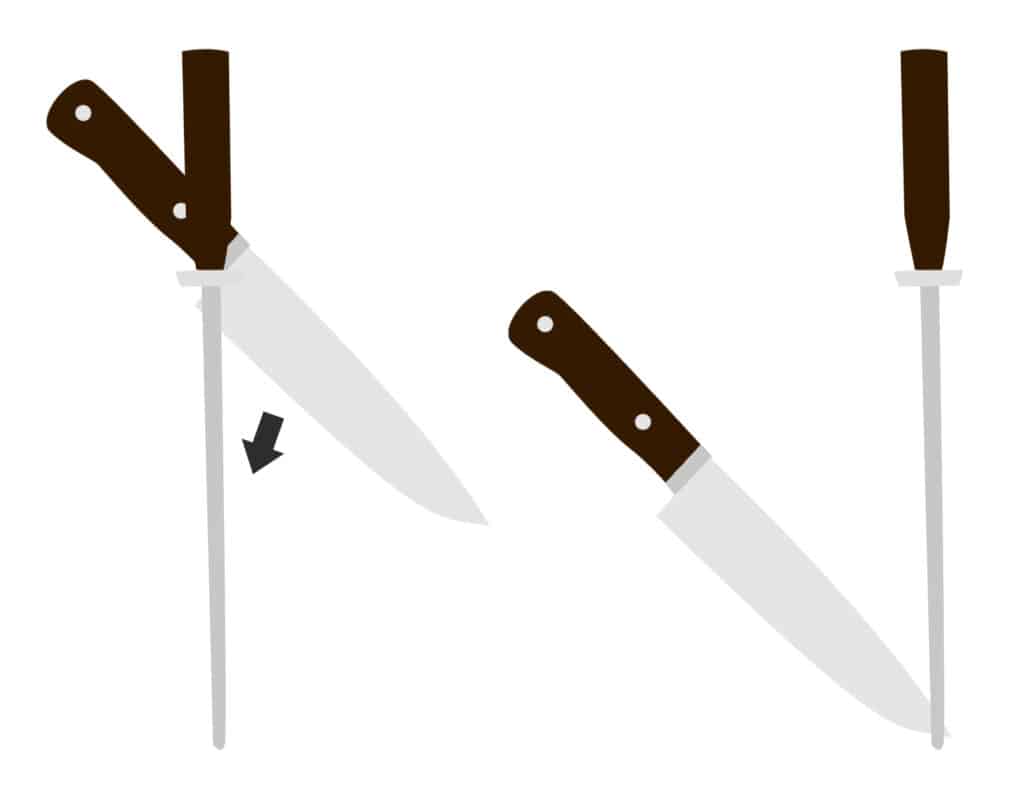
It’s a really easy and quick process. You should only need to pass each side of the knife along the honing steel three or five times before the blade is realigned.
However; you do need to know how often you should hone your knife, so let’s look at that.
How often should you hone a knife
In my opinion, honing a knife is far more important than sharpening and it needs to be done far more often. This is why it’s much more common to see honing steels rather than sharpeners, which is probably also why they often get so easily confused.
The knife edge will begin to go out of alignment very quickly at the microscopic level, literally as soon as you start using the knife. If you think about it, the tiny microscopic teeth on your knife blade edge don’t stand a chance of holding up against the full force of you chopping against a hard surface.
Therefore, you need to hone your knife very frequently. I recommend that you should hone a knife at least every three uses. Honestly, it wouldn’t hurt to hone it after every cooking session, but for the home cook, every three uses should be fine.
Types of honing steels
Finding a honing steel is actually very easy once you know what it’s for. The clue is in the name steel!
If it’s marketed as a honing steel and it is made from steel then that’s fine. They are pretty inexpensive and they last for decades.
This Wüsthof 10 Inch on Amazon (opens new tab) would be a perfect choice and you’ll probably never need to replace it.
What is a knife sharpener
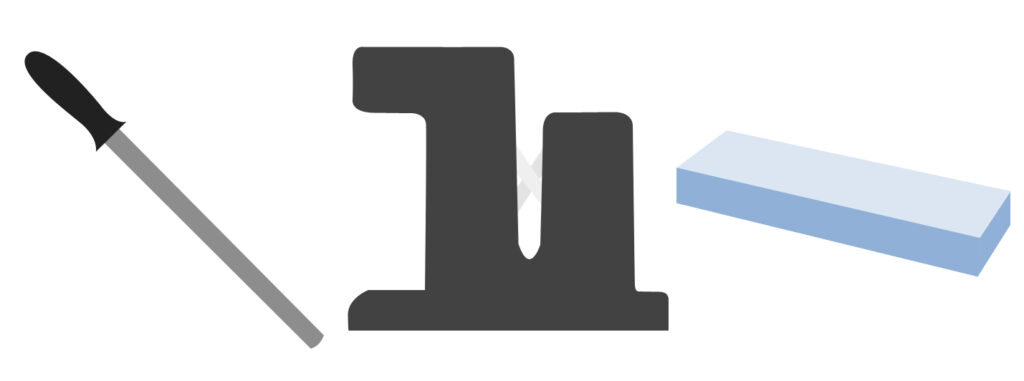
Sharpeners come in many different styles, we’ll discuss the different types of sharpeners below but first, let’s talk about what isn’t a sharpener.
Steel rods are not sharpeners, despite what marketers might say. You can go online now and search for ‘sharpening steel’, or ‘sharpening rod’ and you will be faced with dozens of products which claim to be sharpening rods, but they most probably aren’t.
The reason is that sharpening tools are not made from steel. Now, there might be a few super-strong steel composite sharpeners available which truly do sharpen knives, but in 99% of cases, if you see a ‘sharpener’ which is made from steel then this isn’t really a sharpener at all, it’s a honing rod.
I can only assume that products market themselves as sharpeners when they are actually honing rods because people don’t understand what honing rods are, so the seller is simply trying to describe the product in a relatable way.
The trouble with that is that sharpening and honing are very different. And they need to be done at different frequencies. To fully understand, let’s now take a look into what sharpening a knife is really doing.
What does sharpening a knife do
We have already discussed that honing a knife simply realigns a knife edge which has gone out of alignment, simple.
Sharpening a knife is a different process. When we are sharpening a knife we are doing so because the knife edge has gone so out of alignment, or is so damaged that it simply can’t be realigned using a honing steel. Effectively that edge can no longer be saved, and we need a new one.
Enter the sharpener. Sharpeners must be made from a harder material than the knife, or from an abrasive surface like stone, sharpening stones are usually called whetstones or water stones.
The reason the material must be harder is because it needs to remove a thin layer of the steel blade to unveil a brand new and sharp edge underneath. We’re talking pretty small particles here, almost like steel dust. You can’t achieve this with a material of less or equal strength, it must be stronger.
This is why ‘steel sharpeners’ are nonsense. You can’t remove steel using steel, it’s a bit of an immovable force meets an unstoppable object scenario, there is no winner.
Real sharpeners are made from harder materials, most sharpeners are made from these three materials:
- Diamond encrusted
- Ceramic
- Whetstones or water stones
If the product is made from one of these three then it will sharpen a knife. It’s important to know because there is a huge difference between how often you should hone and how often you should sharpen a knife. Let’s discuss that next.
How often should you sharpen a knife
Sharpening is for more destructive to a knife than honing. Honing just realigns the current edge; however, sharpening actually removes part of your knife.
If you frequently hone your knife (at least every three uses as I mentioned above), then you really shouldn’t need to sharpen your knife very often, perhaps every six months to one year.
Really you will be able to tell when your knife needs to be sharpened because it will be when your knife feels hardly any sharper after honing. This indicates that the blade is just so out of alignment that it simply can’t be realigned with a honing steel and you need to remove the edge.
This frequency difference is the main reason why it’s so important to know the difference between honing, sharpening and which tolls you need.
It would be so easy for someone to mistakenly think you should sharpen your knife often and grin it down with a diamond sharpener every week, this would be terrible for the knife.
Equally, it would be easy for someone to think that using a honing steel every six months is actually sharpening their knife, again this would be wrong and that knife would deteriorate fast.
So now you know what sharpening a knife really means, let’s look at the different types of sharpeners you can use
Types of Sharpeners
There are three materials which most knife sharpeners are made from:
- Diamond
- Ceramic
- Stone, called whetstone or water stone
There are also generally three types of sharpeners which you will find, there are most weird and wonderful ones but the majority of sharpeners you’ll find will fall into these categories:
- Sharpening rod
- Pull through sharpener
- Whetstone or water stone
I’ve written a full article about each type of sharpener and how to use them which you can see here.
As a quick summary, for the home cook, I would probably recommend starting with a ceramic rod. The diamond rods can be pretty harsh on a knife blade just because diamond is so hard. You just have to be a little careful with ceramic rods because they can be brittle, dropping one could see it snap in half. But as long as you’re careful it’ll be fine.
If you want something more advanced for the super sharp finish then I’d recommend using whetstones. They aren’t actually that hard to use once you are used to them and they create a brilliant finish.
The difference between honing and sharpening a knife
If you’ve read everything above then you’ll know the answer to this already, but if you haven’t here’s the simple breakdown.
- Honing realigns a blade which has been folded out of shape
- Sharpening removes a small layer of the blade to reveal a new sharp edge
How to tell the difference between honing and sharpening steels
Again, if you’ve read everything above then you’ll know the answer to this already, but if you haven’t here’s the simple breakdown. It’s all about the material which the tool is made from:
- Honing steels are only made from steel
- Sharpening ‘steels’ don’t exist, even if they are marketed as such. Sharpeners have to be made from a harder material than steel. Diamond, ceramic or whetstone sharpeners will sharpen your knives.
If that doesn’t make sense then I’d recommend reading the ‘What does sharpening a knife do‘ section above.
Is honing or sharpening a knife more important
Most will probably say that both are equally important, but in the real world, I think that honing your knife is by far the most important.
If you hone your knife frequently, at least every three uses, then you will prolong the lifetime of your knives hugely.
Sharpening needs to be done so infrequently that you could honestly go without sharpening for over a year if you hone frequently, and your knives will still last very well.
There are also professional knife sharpening services who will sharpen all your knives and it really isn’t that expensive. So if you want the super whetstone finish but don’t fancy learning the technique then you can bypass getting your own sharpening gear and get a professional to do it.
But if you want to keep a well-maintained knife, you can’t bypass honing!
